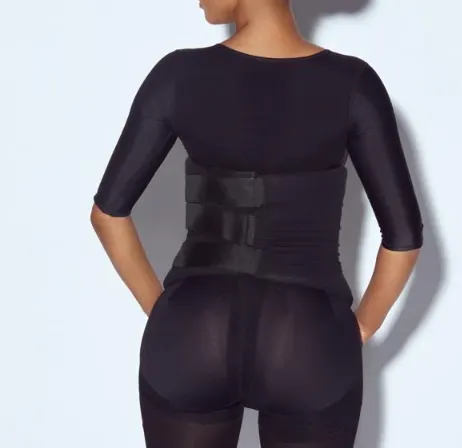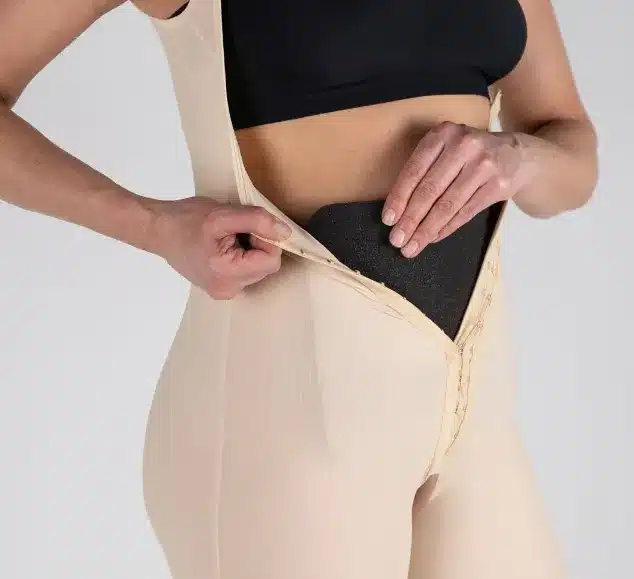Lipo Foam is an essential component of postoperative care, often utilized in conjunction with compression garments to facilitate liposuction recovery. It aids in providing optimal compression, supporting healing, and promoting comfort during the recovery process.
Types of Lipo Foams
Lipo foam, a specialized post-operative care product, is crucial in the recovery process following lipomatic surgery. Its unique properties aid in reducing complications, promoting optimal healing, and enhancing patient comfort. Several lipo foams are designed to cater to specific surgical needs. Let’s take a closer look at each type:
Lipomatic surgery, as a method of fat removal and body contouring, does not inherently come in “different types” in the same way that broad categories of surgery might. Instead, the technique itself is highly specialized and consistent in its approach, utilizing vibrational energy to emulsify fat before it is removed from the body.
Standard Lipo Foam
Standard lipo foam is a basic type of compression foam made from soft and flexible polyurethane material. It is designed to provide uniform compression and support to the treated areas following liposuction or body contouring procedures. Standard lipo foam helps reduce swelling, promote proper skin retraction, and maintain contouring of the body.
Perforated Lipo Foam
Perforated lipo foam features small holes or perforations throughout the foam material, allowing for improved breathability and air circulation. This type of foam is beneficial for patients who experience excessive moisture or sweating under compression garments. Perforated lipo foam helps minimize the risk of skin irritation and discomfort while providing effective compression.
Clinic contact number: +989371200167
Flexible Lipo Foam
Flexible lipo foam is specially formulated to conform easily to the body’s contours, providing a comfortable and secure fit. This type of foam is ideal for areas with irregular shapes or curves, ensuring even compression and support without compromising comfort. Flexible lipo foam helps prevent creasing or folding under compression garments, enhancing overall effectiveness.
Textured Lipo Foam
Textured lipo foam features a textured surface that helps grip the skin and prevent slipping under compression garments. The textured design ensures that the foam stays in place, maintaining consistent pressure over the treated areas. Textured lipo foam is particularly useful for preventing garment adjustments and ensuring optimal compression distribution.

Multi-Layer Lipo Foam
Multi-layer lipo foam consists of multiple layers of foam stacked together to provide enhanced compression and support. This type of foam is suitable for areas that require more intensive contouring or sculpting, such as the abdomen, thighs, or buttocks. Multi-layer lipo foam helps reduce swelling, promote proper healing, and achieve smooth post-operative results.
Silicone-Coated Lipo Foam
Silicone-coated lipo foam is designed with a thin layer of silicone on one side, offering enhanced comfort and protection against skin irritation or friction. The silicone coating reduces the risk of adhesive residue and helps maintain skin integrity during prolonged wear. Silicone-coated lipo foam is suitable for patients with sensitive or delicate skin.
Enhanced Comfort
The silicone coating provides a smooth and soft surface that reduces friction against the skin, minimizing discomfort and irritation during wear.
Skin Protection
Silicone-coated lipo foam helps protect the skin from abrasions, chafing, and pressure points that may occur under compression garments.
Reduced Adhesive Residue
The silicone layer reduces the risk of adhesive residue sticking to the skin, making it easier to remove the foam without causing skin trauma.
Improved Adherence to Garments
The silicone coating enhances the foam’s grip and adherence to compression garments, preventing shifting or slipping during movement.
Moisture Management
Silicone-coated lipo foam assists in managing moisture by creating a barrier between the skin and compression garments, reducing the risk of excessive sweating or skin maceration.
Pre-Cut Lipo Foam Pads
Pre-cut lipo foam pads come in various shapes and sizes, making them convenient for placement over specific treatment areas. These ready-to-use pads can be easily adjusted under compression garments, providing targeted compression and support where needed. Pre-cut lipo foam pads streamline post-operative care and ensure optimal coverage over the surgical sites.
Customized Lipo Foam Inserts
Some lipo foams can be customized to fit the patient’s unique body contours or surgical needs. Customized inserts provide tailored compression and support, optimizing post-operative outcomes and patient comfort. Customized lipo foam inserts are often recommended for complex or individualized procedures.
Clinic contact number: +989371200167
Benefits of Using Lipo Foams
Using lipo foams in the post-operative period offers numerous benefits that contribute to smoother recovery and improved outcomes. Let’s explore six key advantages:
- Enhanced Compression
- Reduced Bruising and Hematomas
- Improved Lymphatic Drainage
- Protection from External Factors
- Comfort and Pain Management
- Faster Healing and Optimal Results
Risks of Not Using Lipo Foams After Lipomatic Surgery
Failing to incorporate lipomatic foams into post-operative care may result in increased swelling, prolonged bruising and hematomas, impaired lymphatic drainage, higher risk of infection, discomfort, and pain, and suboptimal aesthetic results. Failing to incorporate lipomatic foams into the post-operative care regimen can pose several risks and potential complications. Here are six risks associated with not using lipo foams:
- Increased Swelling: Without the proper compression and support provided by lipo foams, swelling can become more pronounced and persistent. Excessive swelling can cause discomfort, hinder recovery, and delay achieving desired aesthetic results.
- Prolonged Bruising and Hematomas: Inadequate support may allow blood to accumulate in the surgical area, resulting in extensive bruising and the formation of hematomas. Prolonged bruising and hematomas cause cosmetic concerns and may require additional treatment to resolve.
- Impaired Lymphatic Drainage: The absence of foam can hinder the natural flow of lymphatic fluids, leading to lymphedema, a condition characterized by the accumulation of lymph fluid in the tissues. Impaired lymphatic drainage can cause discomfort, delay healing, and increase the risk of infection.
- Higher Risk of Infection: Without the protective barrier provided by lipomatic foam, the surgical site becomes more susceptible to external contaminants, such as bacteria and dirt. This increases the risk of infection, which can significantly impact the recovery process and may require additional medical intervention.
How long does it take to heal? According to the Facial Beauty website:
Even in young, healthy patients with good skin quality, it can take several weeks for the skin to fully retract. For the first two to eight weeks, residual swelling will disguise the true results of submental lipo. As the swelling goes down, you should notice the skin retract as well. Generally, within three to six months, noticeable skin retraction will have occurred.

Adoption Trends in Top Hospitals and Surgical Facilities
Lipo Foam, a key component in postoperative care for liposuction patients, has garnered significant attention from leading medical institutions such as Harvard Medical School and Johns Hopkins University. Pioneering researchers like Dr. Simeon Wall Jr., known for his contributions to aesthetic plastic surgery, have explored the efficacy of Lipo Foam in enhancing patient outcomes and reducing complications post-surgery. These esteemed figures have conducted extensive studies on the application techniques and benefits of Lipo Foam, contributing valuable insights to the field of plastic surgery.
In recent years, the demand for Lipo Foam has surged, with hospitals such as the Mayo Clinic and Cedars-Sinai Medical Center adopting its use in liposuction procedures. Companies like Marena Group, a prominent manufacturer of compression garments, have witnessed a remarkable increase in sales of Lipo Foam products. Statistics reveal a substantial rise in the number of liposuction surgeries globally, with an estimated 17.5 million procedures performed in 2023 alone. This surge underscores the growing reliance on advanced postoperative care solutions like Lipo Foam to ensure optimal patient recovery and satisfaction in the rapidly evolving landscape of cosmetic surgery.
Summary
In conclusion, Lipo Foam stands as a crucial element in the realm of postoperative care, particularly in plastic surgery recovery scenarios. Its integration with compression garments enhances the efficacy of both, ensuring optimal healing and comfort for patients undergoing surgical procedures like liposuction. The utilization of foam inserts, such as Lipo Foam, serves to minimize swelling, bruising, and discomfort while providing necessary support to the treated areas. Through its innovative design and functionality, Lipo Foam has become an indispensable tool in the arsenal of surgical foam products, revolutionizing postoperative care protocols and significantly improving patient outcomes.
In the broader context of postoperative care, the synergy between Lipo Foam and compression garments has become a cornerstone of modern surgical practices. Their combined use streamlines the recovery process, promoting better adherence to treatment plans and reducing the risk of complications. As the field of plastic surgery continues to evolve, the importance of integrating advanced solutions like Lipo Foam into postoperative care regimens cannot be overstated. By prioritizing patient comfort, healing, and overall satisfaction, Lipo Foam and similar surgical foam products contribute significantly to the holistic approach of enhancing surgical outcomes and patient well-being.

Fun fact: Did you know that lipo foam sheets are a game-changer in post-surgery recovery? These magical sheets are significant in body contouring, especially after procedures like a tummy tuck.
When used alongside compression garments, lipo foam helps reduce swelling and ensures that the skin remains smooth post any cosmetic surgery. Talk about a beauty secret weapon!
Clinic contact number: +989371200167
FAQs
1: How long should I use lipo foam after surgery? Duration varies based on the case and surgeon’s instructions.
2: Can I wash the lipo foam? Yes, follow the manufacturer’s or surgeon’s cleaning instructions.
3: Can I wear lipo foam under clothing? Yes, it can be worn discreetly under clothing.
4: How is lipo foam used after surgery? Lipo foam is typically cut into strips or pads and placed over the treated areas under compression garments. It conforms to the body’s contours, providing cushioning and support while maintaining consistent pressure.
5: When should lipo foam be worn after liposuction? Lipo foam is usually worn immediately after surgery and throughout the initial recovery period, as directed by the surgeon. It may be worn continuously or for a specified number of hours per day, depending on individual needs.
How Long Does It Take for Skin to Tighten After Chin Liposuction? (facialbeauty.com)



